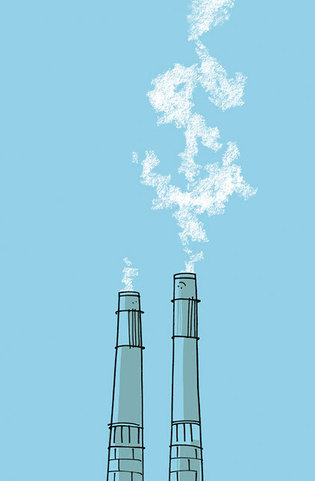 loading
loading
Light & VerityYale tries an internal charge for carbonIf energy use comes at a cost, will it change behavior?  Celia PoirierView full imageTwo years ago, when Jennifer Milikowsky ’15MBA, ’15MF, was a student, she moderated a teach-in panel about solutions to climate change. One of the panelists, Sterling Professor of Economics William Nordhaus ’63, was asked what Yale could do, and he suggested offhandedly that the university implement its own internal carbon-pricing program—a system that would reward or penalize units within Yale for decreasing or increasing their carbon emissions. The idea stuck with Milikowsky. She wrote a memo about it that found its way to President Peter Salovey ’86PhD. Two years later, Milikowsky and Ryan Laemel ’14 find themselves sharing an office in Yale’s facilities department, getting ready to launch what Yale believes is the first-ever carbon-pricing experiment in a university. Both worked on a presidential task force, led by Nordhaus and including School of Management dean Edward Snyder, that investigated the idea. They have developed a six-month pilot project that will test different ways of reducing carbon emissions associated with Yale buildings, as measured by the use of electricity, steam, and/or chilled water. The idea is not to spur capital projects like solar panels or more-efficient mechanical systems; Yale is already pursuing those kinds of changes. “We’re more focused on changing people’s behavior,” says Laemel. “Right now, individuals don’t think much about their energy use.” Twenty Yale buildings, divided into four groups of five, are included in the pilot. Each group includes diverse kinds of buildings—residential, lab, classroom, office. One group will serve as a control, and the other three will each be subject to a different carbon-pricing scheme. In one group, the buildings will effectively compete: the administrative units in them (academic departments, residential colleges, and professional schools, for example) will win or lose money from each other based on whether they have above- or below-average energy consumption. In others, departments will be measured not against each other but against preset targets, with charges or rebates based on whether they meet the target. In all cases, the price of carbon is set at $40 per metric ton of carbon dioxide equivalent (MTCDE)—the federal government’s figure for the “social cost of carbon.” Yale currently emits about 300,000 MTCDE per year, or $12 million worth at the $40 rate. The task force, coordinated by Ted Wittenstein, a lecturer at Yale’s Jackson Institute, will evaluate the pilot project in the spring. If it is successful, they will devise a larger program. A number of corporations—including Microsoft and Disney—have implemented carbon-pricing schemes, but Yale will be the first university to do so. “There isn’t a consensus about what kind of pricing system would work best at a university,” says Milikowsky. “We’re excited about finding the best policy, and we want to take the time to do it right. Because a lot of schools are interested in how it comes out.”
The comment period has expired.
|
|